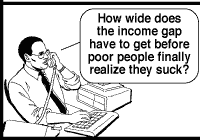Of course, these are probably the same dopes who said it was going to snow in Philly last Sunday night, so dere's a good chance of either nothing happening or the world coming to an end without warning... and anudder reason not to get a cell phone.
From NOAA via "GIM International" newsletter:
http://www.gim-international.com/news/id2773-NOAA_Forthcoming_Solar_Cycle_Could_Disrupt_GPS,_Communications.html
Source: NOAA Website: http://www.noaa.gov
NOAA: Forthcoming Solar Cycle Could Disrupt GPS, Communications
10/01/2008
A new 11-year cycle of heightened solar activity, bringing with it increased risks for military and civilian communications, including GPS signals, showed signs it was on it its way with the appearance of the cycle's first sunspot, NOAA scientists said.
The sunspot appeared in the sun's Northern Hemisphere, according to the U.S. National Oceanic and Atmospheric Administration (NOAA). "This sunspot is like the first robin of spring," said solar physicist Douglas Biesecker of Nova's Space Weather Prediction Center. "In this case, it's an early omen of solar storms that will gradually increase over the next few years."
A sunspot is an area of highly organized magnetic activity on the surface of the sun. The new 11-year cycle, called solar cycle 24, is expected to build gradually, with the number of sunspots and solar storms reaching a maximum by 2011 or 2012, though devastating storms can occur at any time, according to NOAA.
During a solar storm, highly charged material ejected from the sun may head toward Earth, where it can bring down power grids, disrupt critical communications, and threaten astronauts with harmful radiation. Storms can also knock out commercial communications satellites and swamp GPS signals. Routine activities such as talking on a cell phone or getting money from an ATM could suddenly halt over a large part of the globe, NOAA warned.
"Our growing dependence on highly sophisticated, space-based technologies means we are far more vulnerable to space weather today than in the past," said Vice Admiral Conrad C. Lautenbacher, Jr., undersecretary of commerce for oceans and atmosphere and NOAA administrator. "[NOAA's] space weather monitoring and forecasts are critical for the nation's ability to function smoothly during solar disturbances."
Last April, in coordination with an international panel of solar experts, NOAA issued a forecast that solar cycle 24 would start in March 2008, plus or minus six months. The panel was evenly split between those predicting a strong or weak cycle. Both camps agree that the sooner the new cycle takes over the waning previous cycle, the more likely that it will be a strong season with many sunspots and major storms, said Biesecker. Many more sunspots with solar cycle 24 traits must emerge before scientists consider the new cycle dominant, with the potential for more frequent storms, NOAA said.
The new sunspot, identified as #10,981, is the latest visible spot to appear since NOAA began numbering them on January 5, 1972. Its high-latitude location at 27 degrees North, and its negative polarity leading to the right in the Northern Hemisphere are clear-cut signs of a new solar cycle, according to NOAA experts. The first active regions and sunspots of a new solar cycle can emerge at high latitudes while those from the previous cycle continue to form closer to the equator.
Subscribe to:
Post Comments (Atom)
























No comments:
Post a Comment